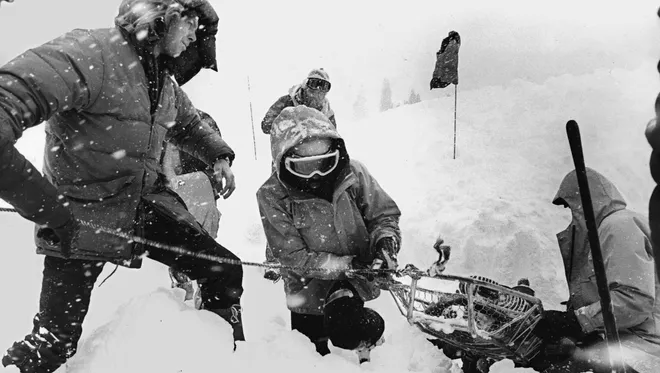Palisades avalanche near Lake Tahoe is a reminder of the dangers of snow sports
An avalanche that barreled down a California ski resort Wednesday near Lake Tahoe, killing one and injuring three others, reminded winter recreationists across the country the dangers of snow sports.
Skiing and snowboarding are among the most popular winter sports in the United States. Millions of Americans participate in snow sports each year and in the 2022-23 winter season, the National Ski Areas Association (NSAAA) estimated a historic high of 11.6 million participants. But the beloved pastime comes with risks.
Experts and industry groups have long cautioned recreationists that these sports can cause severe injuries or even death. Excess speed, loss of control, and collisions with stationary objects, such as trees, are the most common factors associated with snow sports incidents, according to the National Safety Council.
Skiers and snowboarders, the U.S. Forest Service added, must also "reckon with the deadly forces of snowy torrents" that rapidly slide down mountainsides.
"Climbers, backcountry skiers, and snowmobilers are by far the most likely to be involved in avalanches," according to the U.S. Forest Service. "One of the major reasons for increasing avalanche fatalities is the boom in mountain industries and recreation."
Dozens of avalanche fatalities occur each year in the United States, mostly involving backcountry skiers, snowboarders, and snowmobilers, according to the Colorado Avalanche Information Center (CAIC).
Unburying the past:Lake Tahoe documentary revisits deadly 1982 avalanche
Avalanches in backcountry areas vs. ski areas
Backcountry recreationists are more likely to trigger avalanches when they cross hazardous terrain, the U.S. Forest Service noted. In winter recreation, the Northwest Avalanche Center (NWAC) said "the backcountry" describes mountainous areas where no avalanche mitigation is conducted.
"In contrast, most downhill ski areas in North America aren’t considered backcountry terrain," according to the center. In ski areas, or ski resorts, patrollers try to reduce avalanche risks by triggering avalanches or closing areas that are dangerous.
Avalanches are unstable masses of snow that slide down a slope, Sierra Avalanche Center forecaster Andy Anderson told USA TODAY. While avalanches can occur during any time of the year, the vast majority happen during the winter.
Weather conditions impact snowpack structures, according to Anderson, which can lead to avalanche activity on weak layers. But what is "often more worrisome" is when the weak layer in the snowpack is broken, Anderson said.
"The tipping point may be a person recreated on top of the snowpack, like a skier or snowmobiler or someone who's out in the backcountry, and when their weight adds to the top of the snow then they sometimes can trigger an avalanche," Anderson added.
Avalanches can quickly reach speeds up to 100 mph and can vary in destructive power, according to Avalanche.org, an avalanche education partnership between the American Avalanche Association and the U.S. Forest Service National Avalanche Center. In the U.S., avalanches kill 25 to 30 people and injure many more each winter.
A total of 30 people were killed by avalanches during the 2022-23 season, according to the CAIC.

Avalanches at ski resorts can be devastating
Despite efforts to mitigate avalanche danger in ski areas, the risk can rarely be eliminated, according to the NWAC. Numerous incidents have occurred near Lake Tahoe, including Wednesday's avalanche.
In January 2020, a skier died at Alpine Meadows in the area between Scott Chute and Promised Land, the Reno Gazette-Journal, part of the USA TODAY Network, reported. And one of the deadliest avalanches in U.S. history also occurred at Alpine Meadows.
In late March of 1982, a series of storms dropped nearly 7 feet of snow in four days, piling on top of a base snowpack already measuring more than 7 feet. While Alpine Meadows closed due to the heavy snow, a crew of 13 remained on site.
The avalanche brought millions of tons of snow down, destroying heavy equipment and a two-story ski lift workers' building. The slide killed seven people, including an 11-year-old girl.
Snows sports always come with risks
Snow sports are inherently risky. Skiers and snowboarders have been advised by industry experts, such as the NSAA, to be aware of adverse weather conditions, changing snow conditions, machinery working on slopes, and other recreationists.
During the 2022-23 U.S. ski season, the NSAA reported 46 skier and snowboarder fatalities in ski areas. The total number of fatalities for the season was also slightly higher than the 10-year industry average of 42 fatalities per season, according to the NSAA.
The primary factors of these fatal incidents included speed, loss of control, and collisions with objects on slopes. The season also had record-breaking snowfall, the NSAA said, which contributed to an "unusually high number" of deep snow immersion fatalities.
Contributing: Brett McGinness and Amy Alonzo, Reno Gazette-Journal
Disclaimer: The copyright of this article belongs to the original author. Reposting this article is solely for the purpose of information dissemination and does not constitute any investment advice. If there is any infringement, please contact us immediately. We will make corrections or deletions as necessary. Thank you.







